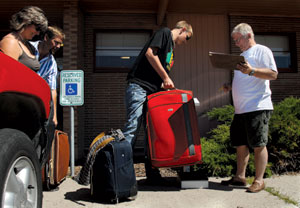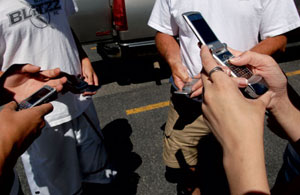When Marcos Gamberini learned he had been placed in Bozeman for his high school foreign exchange, the 17-year-old Brazilian had one question: “Montana? Where the hell is Montana? I thought I was supposed to be going to the U.S.”
Nine months later, though, Gamberini and 18 other students – many of whom recalled similar initial reactions to their placements – reluctantly said goodbye to their Montana friends and host families in Whitefish. Montana, they said, had become a second home, and the exchange a defining experience of their young lives.
The group of teens represents a growing interest in study abroad in the Flathead Valley and the broader region. Volunteer agencies, charged with finding local host families for foreign high school students, have far more interested children than they do homes.
Last year, the Center for Cultural Exchange, another nonprofit international exchange organization added its first local representative in the Flathead, Lakeside resident Cindy Hendrick, largely because of growing interest in the area.
 |
|
Host parents Diane Yarus, and Bill Yarus, left to right, watch as German foreign exchange student Joschka Hey weighs his bags with a little help from Ray Boksich. The students are allowed two bags that can’t weight over 50 pounds each on their flights back to their home countries. |
Hendrick said the organization had about 250 foreign students apply this year for placement in the western region, which includes Montana, Wyoming, North Dakota and parts of Idaho and Washington. Three of those students have already found homes in the Flathead, but 27 kids are still looking for host families somewhere in the region.
“Students have shown a huge, huge interest in coming to this area – the exchange rate is more affordable for them right now, and this area is viewed as safer than more urban spots in the U.S.,” Hendrick said. The response from the community, she added, has been slow to accommodate the growing numbers of foreign students. “But, I think it’s just a matter of explaining the process and helping people understand the opportunities.”
The American Field Service, the group that brought Gamberini and 23 other foreign students to the state last year, is also still looking for hosts for the next school year, local volunteer Ray Boksich said.
Study abroad students from foreign schools largely pay for themselves, according to the two local organizations. The students come with their own insurance and spending money and host families are asked to provide food, shelter and a welcoming atmosphere. The students are tested for their English language abilities and the groups help local families choose a compatible match. In the rare case a student and family don’t get along, local reps are there to mediate or facilitate a switch.
Boksich, a Whitefish resident, and his wife Jerrie have hosted 17 exchange students since joining AFS. He credits the program with putting “the travel bug” in his biological children and broadening his family’s world perspective.
“People ask which one was my favorite,” he said. “I tell them they each had their best day and their worst day, but when it comes time to say goodbye you never want to let those kids go.”
Meanwhile, opportunities for local residents to have similar experiences in other countries are expanding. In the past year, Flathead Valley Community College has offered study abroad trips to Peru and Nepal and next spring, the community college will take students on its first full-semester exchange – a trip to Venice, Italy.
 |
|
Exchange student Alessandro Virgillito, left, shares his phone number with his host family, Sam Warwood, Bryan Warwood and Erica Crisafulli, left to right, outside Whitefish Independent High School. |
“All of a sudden we’re kind of getting into this in a big way for a community college,” FVCC counselor Greg Shryock said. “It’s not a real traditional role for a community college, but it’s a global world and students are more and more interested in those experiences.”
But planning those experiences for locales that are both interesting and affordable is a challenge in today’s economy.
Many American college and high school students, hit by the sticker shock of unfavorable exchange rates, are reconsidering favorite destinations like Western Europe and are increasingly opting for nontraditional programs in Asia, Africa and Latin America. Many of those areas are less expensive than their European counterparts to begin with and have currencies that haven’t been as rough on the dollar.
Study abroad trips to Argentina grew by 42 percent from 2005 to 2006, while study in China was up by 38 percent over the same period, according to the Institute of International Education, a New York-based nonprofit.
When art professor John Rawlings began planning last year for the Venice trip, he was worried the costs would keep students away. “I bid this trip last October at what I thought was an extraordinary Euro at $1.45,” he said. “Now, it’s at $1.65.’”
Still, locals rushed to join in the exchange at its original cost of $12,480. Five days after Rawlings announced the trip, the 20-person roster was full and another dozen had formed a waiting list. And, despite a now uncertain price tag and a lagging dollar, no one in the original group has relinquished their spot.
Participants in FVCC’s study abroad programs have also enjoyed rich cultural experiences in Nepal and Peru in the last year – without some of the pocketbook pinch.
“For everything we did in Nepal – six weeks stay, flight, food and everything – it was a very affordable rate for long-term travel,” Mick Stemborski, director of FVCC’s multicultural services office, said of the $3,400 trip.
This July Stemborski will lead his second cultural immersion trip to The Sacred Valley outside of Cusco, Peru, where participants can earn up to seven class credits in three weeks. And come December, he plans to take a group to Maui, Hawaii for two weeks of anthropological and cultural study.
No matter the financial cost, though, Stemborski said participants in any travel abroad program are signing up for a life-changing experience. It was a message echoed frequently by the high school exchange students as well.
“When I leave here I will not say goodbye to my host family,” 17-year-old Giuseppe Distefanl, a Sicilian who stayed with the Boksich family this past year, said. “I will say, ‘See you again,’ because I know I will come back. It’s been too important to just leave forever.”